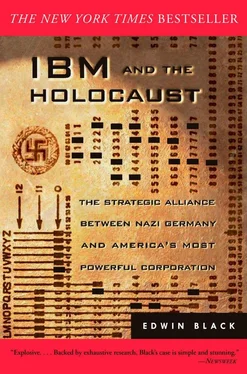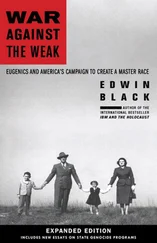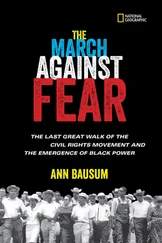Just below the rear watchtower, a round-topped furnace squatted atop the mud. Black and elongated, the furnace resembled a locomotive engine, but with two weighty kiln doors at the front. Its single, tall, sooty smokestack rose several meters into the air. A hand-made metal stretcher of sorts, used to slide emaciated corpses into the flames, was always nearby. Here was the crematorium. Not hidden out of sight, nor obscured by structures or berms, the crematorium was close enough to burn the eyes of any SS guard stationed in the watchtower. The ominous structure and its message were visible to all as the final way station should fate falter—or deliver. 3
Situated between two rivers and the towns Bergen and Belsen, the site was originally established in spring 1943 as a prisoner transit camp for 10,000 Jews who might be ransomed or traded. But in the last months of 1944 and early 1945, as Nazi death camps, including Auschwitz, were liberated by the Allies, Belsen became a nightmare of human consolidation, receiving transports from other sites. By spring 1945, more than 40,000 were imprisoned under indescribable conditions. Starved, worked to death, and randomly tortured, the death toll rose to nearly 20,000 just for the month of March 1945. After liberation, horrified British medical teams were unable to save some 14,000 dying souls. Eventually bulldozers were deployed to gruesomely shovel bodies into trenches of twisted rigor mortis. 4
Just meters from the Belsen crematorium, off to the left, near the kitchens and the cisterns, down a muddy path, stood the block leader’s house. Inmates sometimes called this place “the lion’s den.” Within “the lion’s den” was a room for the Arbeitsdienstfuhrer, the Labor Service Leader. That is where the Hollerith punch cards were processed. At first glance, they seemed like simple rectangular cards, five and a quarter inches long, three and a quarter inches tall, divided into numbered columns with holes punched in various rows. 5But they were much more than simple cards.
Beginning in December 1944, a Dutch Jew, Rudolf Cheim, was assigned to work in the Labor Service Office. Hungry and desperate to stay warm, Cheim tried every cold morning to locate a bit of extra food and some matches to make a fire. Kindling was stacked in the office. But no matches. For those, Cheim needed to venture into the other room where the SS officers slouched on chairs. Invariably, they viciously punched him in the face as the price for walking near to obtain a match. But it was worth it for Cheim. He could survive. 6
Working in the Arbeitsdienst was good. The Labor Service Office held the power of life or death over prisoners, including him. If an inmate could work, he could live. Cheim was happy for an office assignment working with the Hollerith punch cards and their coded numbers. But as he did, he silently observed through the corner of his eye the SS men administering the card sorting procedure. For five weeks he took mental notes. 7
Quickly, Cheim learned the method. Every day, transports of slave laborers were received. Prisoners were identified by descriptive Hollerith cards, each with columns and punched holes detailing nationality, date of birth, marital status, number of children, reason for incarceration, physical characteristics, and work skills. Sixteen coded categories of prisoners were listed in columns 3 and 4, depending upon the hole position: hole 3 signified homosexual, hole 9 for anti-social, hole 12 for Gypsy. Hole 8 designated a Jew. Printouts based on the cards listed the prisoners by personal code number as well. 8
Column 34 was labeled “Reason for Departure.” Code 2 simply meant transferred to another camp for continuing labor. Natural death was coded 3. Execution was coded 4. Suicide coded 5. The ominous code 6 designated “special handling,” the term commonly understood as extermination, either in a gas chamber, by hanging, or by gunshot. 9
For some two years as the trains and trucks rolled in from Belgium, France, and Holland, thousands of punch cards were examined, processed, and the information fed back to the Department of Statistics at the SS Economics Office in Oranien burg. The numbered men and women were compared to a list of work needs at Bergen-Belsen and other camps. “Never a name,” Cheim remembers, “only the assigned numbers.” How many died was just a statistic to note, a detail for the machines to digest. That December 1944, some 20,000 prisoners were registered; 50 deaths per day, on average, were recorded on punch cards. 10
Cheim learned that to discover the occupational make-up of a prisoner group, each inmate’s individual punch card was fed into the mechanical sorter. Then the dials were adjusted to isolate certain professions, labor skills, age groups, or language abilities needed for work battalions. If prisoners were selected for work, their names appeared on a Hollerith printout for transport to nearby sub-camps, factories, and even local farms. 11
Labor requirements were reported and then matched by Office D II of the SS Economics Office, which administered all the camps under Gen. Oswald Pohl. Pohl, creator of the “Extermination by Labor” program, ardently argued that expeditiously gassing Jews deprived the Reich of an important resource. His idea, “Extermination by Labor,” quite simply meant working Jews to death. Only after outliving their usefulness would they be deported to death camps for gassing. Office D II embraced SS Chief Heinrich Himmler’s declaration: “If 10,000 Russian females collapse from exhaustion while digging a tank ditch, it interests me only so far as the tank ditch is completed for Germany.” 12
Cheim took special notice one day when five women escaped from Bergen-Belsen. Angry SS guards vowed to recapture them. They resented reporting the prisoner departures in column 34 of the punch card forms as code 7—escaped. 13
He became fascinated with a young Dutch seamstress. Who was she? Her journey began in the Westerbork camp. Went to Auschwitz. She was born May 10, 1924. No name. Just a number. 53752. But who was 53752, Cheim wondered? Did she not have a name, only a number? 14
Cheim soon began to understand the truth. Hundreds of thousands of human beings were being identified, sorted, assigned, and transported by means of the Hollerith system. Numbers and punch cards had dehumanized them all, he thought. Numbers and punch cards would probably kill them all. But Cheim never understood where the Hollerith system came from. 15
One December morning, even as the numbered man Cheim, in his tattered uniform, stepped quickly toward the Bergen-Belsen Hollerith office to stay warm and to stay alive, another man, this one dressed elegantly in a fine suit and warm overcoat, stepped out of a new chauffeured car at 590 Madison Avenue in New York. He was Thomas J. Watson. His company, IBM—one of the biggest in the world—custom-designed and leased the Hollerith card sorting system to the Third Reich for use at Bergen-Belsen and most of the other concentration camps. International Business Machines also serviced its machines almost monthly, and trained Nazi personnel to use the intricate systems. Duplicate copies of code books were kept in IBM’s offices in case field books were lost. What’s more, his company was the exclusive source for up to 1.5 billion punch cards the Reich required each year to run its machines. 16
Indeed, the systems were not only used in the concentration camps, but hundreds of them had been installed for years throughout the entire commercial, industrial, war-making, and anti-Jewish infrastructure of Nazi Germany and Nazi-dominated Europe.
On this cold December day, Watson was unyielding. His German subsidiary, Dehomag, was out of control. More lawyers would be called, more telegrams would be sent, more clever maneuvering with the State Department would be undertaken—not to stop Dehomag from its genocidal partnership with the Third Reich, but to ensure that all the proceeds and profits remained with IBM NY. No matter who won, IBM would prosper. Business was its middle name.
Читать дальше












